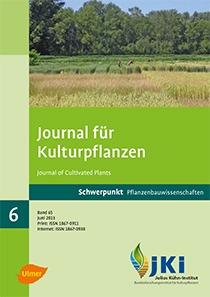Comparison of uniform control and site-specific model-based nitrogen prescription in terms of grain yield, nitrogen use efficiency and economic aspects in a heterogeneous corn field
DOI:
https://doi.org/10.5073/JfK.2013.06.03Keywords:
Corn, nitrogen rate, yield, variability, modelAbstract
In Europe, and especially in Germany, the land area cultivated with corn over the last decade has continuously been increasing. Several studies indicated that corn production has a high risk of nitrogen leaching, thus the current nitrogen management strategy needs to be verified and compared with new management strategies. The objective of this study was to investigate and to evaluate uniform (control) and model-based (site-specific) nitrogen management strategies in terms of corn grain yield, nitrogen use efficiency and economic aspects. Field trials were conducted at an experimental station as part of Hohenheim University over a three-year period (2006–2008). Nitrogen application rate was varied to meet the given heterogeneity on the field. The crop growth model APOLLO was employed with using (site-specific) input data, including soil texture, weather, cultivar, management and historical yield data, in order to model corn yield depending on nitrogen fertilization rate variations.
In the experimental design, the field was separated in 48 management units. Within each management unit, a uniform control treatment and a site-specific model-based treatment were applied.
For the nitrogen application, a map was created and the fertilizer was broadcast accordingly at 130 kg N ha–1 for uniform control treatment and 100–210 kg N ha–1 for the site-specific treatment in line with the model results. Corn grain yield was acquired with a yield-mapping device on a combine harvester.
The two different nitrogen management strategies resulted in yield advantages for the model-based treatment compared to the uniform control treatment. Concerning corn grain yield and marginal net return, significant differences were determined between both nitrogen treatments. However, no significant differences were found for nitrogen use efficiency between the uniform control and the site-specific model-based nitrogen treatments. Further investigations of yield driving factors need to be performed in order to optimize corn grain yield according to a given within field heterogeneity.
Published
Issue
Section
License
The content of the journal is licensed under the Creative Commons Attribution 4.0 License. Any user is free to share and adapt (remix, transform, build upon) the content as long as the original publication is attributed (authors, title, year, journal, issue, pages).
The copyright of the published work remains with the authors. The authors grant the Journal of Cultivated Plants, the Julius Kühn-Institut and the OpenAgrar repository the non-exclusive right to distribute and exploit the work.







